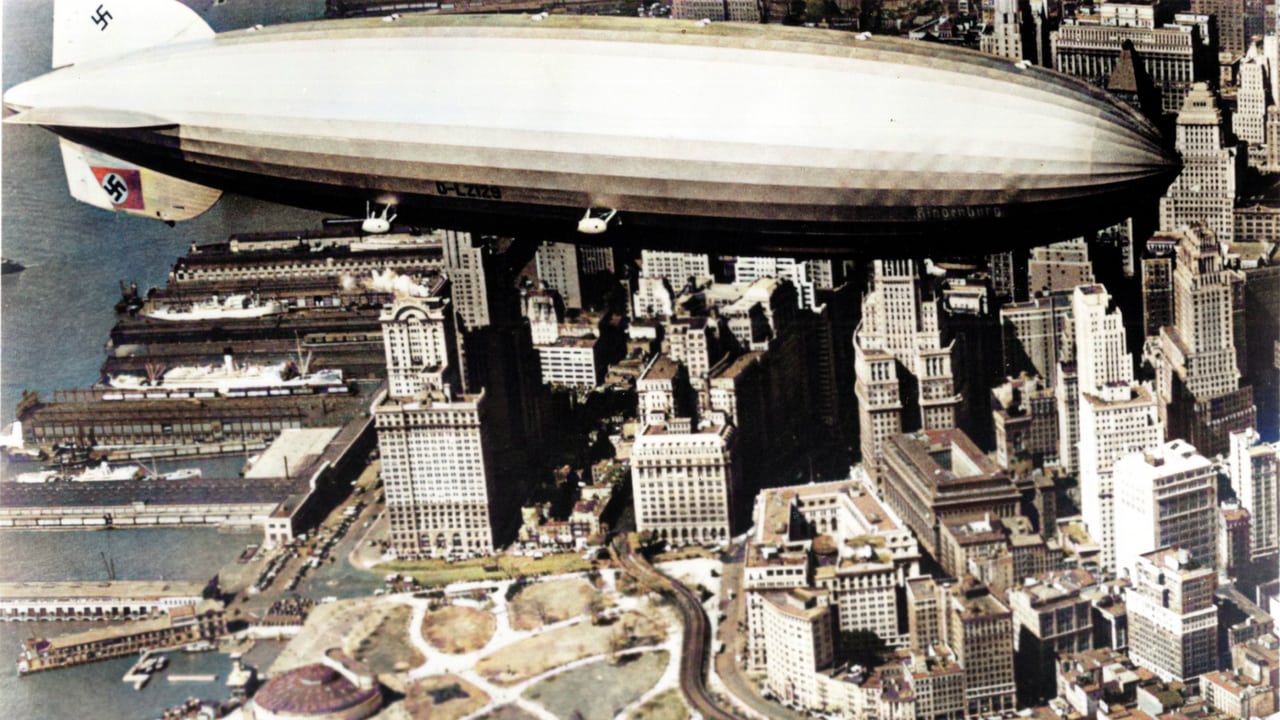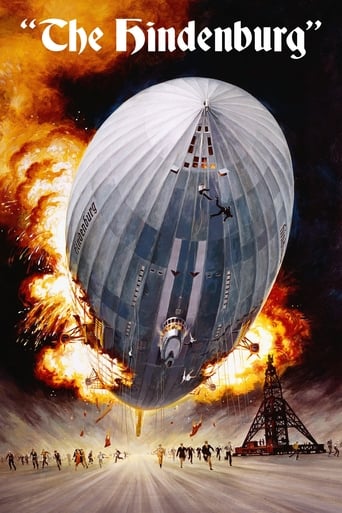

This highly fictionalized (and speculative) account of the famous Hindenburg disaster, a fiery crash that effectively ended the Zeppelin age, at the time Germany's pride and joy, has a lot going for it: a stellar cast that performs brilliantly, direction by one of Hollywood's master directors, and some of the best special effects in the disaster genre. Unfortunately, all of the excitement in this film is concentrated in the crash sequence. Terrifyingly real and with great visual effects and editing, this final sequence takes almost fifteen minutes to play out what took only a matter of seconds in real life (hydrogen burns incredibly fast) and makes for a great climax. The problem is we have to wait nearly two hours for the only excitement this movie provides.The story is a jumbled hash of speculation and rumor; the film concludes that it was a bomb that took down the great airship though there has never been any proof that this was the case. In fact the most annoying thing about this film is that the Hindenburg disaster remains to this day an unsolved mystery and Richard Levinson and William Link's script makes the colossal mistake of providing an answer to the mystery. Not that the conclusion they arrive at is lacking in credibility, but it would have been better had they not addressed it.But then, of course, they might not have had a movie. Because most of the two hours leading up to the final cataclysm is taken up with a mishmash of plots and suspicious characters, always suggesting one thing or another but never really landing on any credible conclusions.And for a movie directed by the man who gave us WEST SIDE STORY, the pacing of this thing is positively glacial. Perhaps he thought he was providing suspense, but I found most of it insufferably boring despite the fact that the characters are a lively and interesting bunch. Somehow not even the efforts of the brilliant ensemble can alter the fact that the whole thing is a crashing bore until the crash (you should excuse the pun).It was a good try, I suppose, but maybe in the end the story was not filmable.
... View MoreDisaster movies are easy targets, but not for the obvious reasons.There is something cynical and voyeuristic about watching mass destruction and wholesale slaughter as entertainment. So after viewing such things our guilt reflex kicks in and we lash out at the source of our embarrassment and don't take the personal responsibility for our behavior.Most of the these films are a mediocre mishmash of boring characters played by big-name stars and big-budget special effects that are a mixed bag. The reason these keep being made is that most of the time they are money makers from movie makers that have no qualms about exploiting this rubbernecking public neurosis. The Hindenburg has as much to offer as any of its DM cousins and as much to criticize. Disturbingly stylistic, the actual demise is different and dramatized in a way that is surprising and distressing. Listen closely for some excellent sound editing. The odd, after the disaster ending and the detached overly punctuated way of listing the casualties is rather a curiosity. It is delivered something like this...dead...dead...dead...survived...survived...survived...dead dead...survived survived...dead dead dead dead dead...survived survived survived survived...dead survived dead dead dead
... View MoreApart from the sinking of the "Titanic", the loss of the German airship "Hindenburg" at Lakehurst, New Jersey, in 1937 was perhaps the most famous disaster of the twentieth century, so it is perhaps unsurprising that this film should have been made during the 1970s, the Golden Age of the disaster movie. There is, however, a difference between "The Hindenburg" and the standard seventies disaster flick in that it is a period piece based on a real-life disaster; most such films were set in the present day and told fictional stories.There is another difference between this film and films like "The Towering Inferno", "The Poseidon Adventure" or the various versions of the "Titanic" story. In those films the disaster happened over a longer period of time; the "Titanic", for example, took over two hours to sink after hitting the iceberg, so when James Cameron filmed the story he was able to use the second half of the movie to show the disaster as it happened, in virtually real time. The fire which destroyed the "Hindenburg", by contrast, took only a few minutes to consume the airship, and only takes up a small part of the film's running time. The film-makers, therefore, needed to come up with something else to make a full-length feature film out of the disaster.The true cause of the "Hindenburg" disaster remains unknown to this day, but the film explores the theory that the airship was destroyed as a deliberate act of sabotage by forces opposed to the Nazi regime. The main character is Franz Ritter, a Colonel in the Luftwaffe and the "Hindenburg's" security officer. Ritter discovers that there is a plot to destroy the airship and works desperately to thwart it. He himself, however, is becoming disillusioned with the Nazis (whom he originally supported) so has some sympathy with the anti-Nazi opposition. In reality no firm evidence for sabotage has ever been found, but there is also no firm evidence which would definitely rule it out, so this aspect of the film is not so much a distortion of history as an exploration of a possible, if unproven, theory. In some respects, however, the film-makers do alter the facts to suit the story. For example, in the film the airship's captain Max Pruss delays his landing because of adverse weather conditions (a key plot point), whereas in fact no such delay took place.The film's main drawback is that it just does not work as a thriller. We all know that the "Hindenburg" was indeed destroyed and we therefore realise that Ritter's efforts to prevent its destruction will prove vain. It therefore generates very little tension. Films about the "Titanic" disaster suffer from the same drawback, but both Cameron and the makers of the earlier 1953 film about the sinking are able to overcome this problem by creating characters we can care about. The important question therefore becomes, not "will the ship sink?" (we know it will), but rather "can Jack and Rose, or the Sturges family, survive the sinking?" "The Hindenburg" does not give us any characters we can identify with in this way. Most of them, including the saboteur, are fairly sketchily drawn. The only one to be fully developed is George C. Scott's Ritter, and even he is not particularly sympathetic. A man who has taken four years to realise that Hitler might not actually be the great saviour of the nation he was hoping for makes an unlikely hero for a Hollywood blockbuster. The other major star in this production is Anne Bancroft as Countess Ursula von Reugen, an old friend of Ritter, but she does not have a lot to do. (Although both Scott and Bancroft were big stars in their day, and had leading roles in many films, both today are largely remembered for one single role, General Patton in his case and Mrs Robinson from "The Graduate" in hers).On the plus side, the final scenes of the disaster are reasonably convincing, as is the period reconstruction of the 1930s, and there is a witty comic song called "There's a Lot to Be Said for the Fuehrer", actually an ironic piece of anti-Nazi propaganda, which sounds like something . Overall, however, this is one of the weaker disaster movies of the seventies, better than "The Cassandra Crossing"- it would be difficult to be worse- but not as good as, say, "Jaws", "Earthquake" or "The Towering Inferno". There's not a lot to be said for "The Hindenburg". 5/10 A goof. One of the German characters has the surname "Boerth". In German this would be pronounced (approximately) like the name "Bert", but throughout the film it is mispronounced to rhyme with "fourth".
... View More"The Hindenburg" is a speculative thriller by Robert Wise. Wise often picked interesting material, and this one revolves around a supposed conspiracy which took place aboard The Hindenburg, the famous German airship which was destroyed by fire on May 6th, 1937. The Hindeburg was and still is the longest flying machine ever created by man.There's something crass about using a real-life disaster for a thriller plot, but ignore this and the film has some interesting elements. For most of its running time, for example, "Hindenburg" functions like an Agatha Christie styled mystery, actor George C. Scott playing a Luftwaffe security agent tasked with protecting the airship from various threats. In this regard, the first half of the film delights in laying out several red-herrings and false leads, we the audience unsure as to which of the airship's passengers or crew may be plotting its demise. Scott himself suspects that anti-Hitler terrorists are plotting to "symbolically" blow up the Hindenburg, but what's unique here is that he sympathises with the saboteurs and has no scruples with them carrying out their actions.Mostly, though, the film works best when it's completely ignoring its thriller plot. Scott, who spends the film brooding awesomely (like a noir detective, a kind of pensive, ageing Bogart), has various "romantic" encounters with middle aged women, which Wise suffuses with wistful dialogue and magnificently melodramatic tunes courtesy composer David Shire. Another good scene features a satirical, anti-Nazi song. Even better are the film's evocative special effect shots, most of which were done by Albert Whitlock, regarded by many as the best matte artist of all time. His work is beautiful and convincing, and the film's shots of bulbous airships, skylines, landing strips and landscapes are at times special, particularly a few shots in which Whitlock recreates famous photos of the Hindenburg flying over Europe and the New York skyline. You have to be an aviation buff to like this stuff.Unfortunately whatever merit the film has is completely undermined by its climax. The film's last act is horrible, Wise inter-cutting real footage of the Hindenburg's demise with poor special effects shots and much silly carnage. He also makes the decision to shoot the calamity in black-and-white, so as to match up with historical, archival footage. It's a poor decision. If you can't render the airship's destruction convincingly with special effects, omit the destruction altogether. Have it alluded to in some other way. The film's climax ruins the entire film.Airships have a certain beauty about them. They conjure up a very specific type of romanticism; the romanticism of the 1930s, of flying, of new-fandangled air machines, heroic pilots and aviator sunglasses. It used to be an adventure to fly, glamorous even. Now air-machines are antiseptic and airports have all the allure of bus terminals. Incidentally, outside the Hindenburg, the most famous airship is perhaps the Graf Zeppelin, a massive German passenger airship which circumnavigated the globe in 1929. It had a spotless safety record, was made famous by various newsreels and documentaries which delighted in capturing its gigantic mass as it heaved itself over cities, oceans and skyscrapers, but was ultimately dismantled by the Nazis at the outset of WW2. As America had a monopoly on non-flammable gas, and as the public lost faith in the use of flammable hydrogen post the Hindenburg disaster, Germany's "age of airships" eventually ended come the 1940s. Before this, many interesting plans were made to retrofit skyscrapers and buildings in London and New York. The top floors of the Empire State Building, for example, were to house the docking ports and headquarters of American Zeppelins. So cool.7.9/10 – Worth one viewing. See "The Sand Pebbles".
... View More